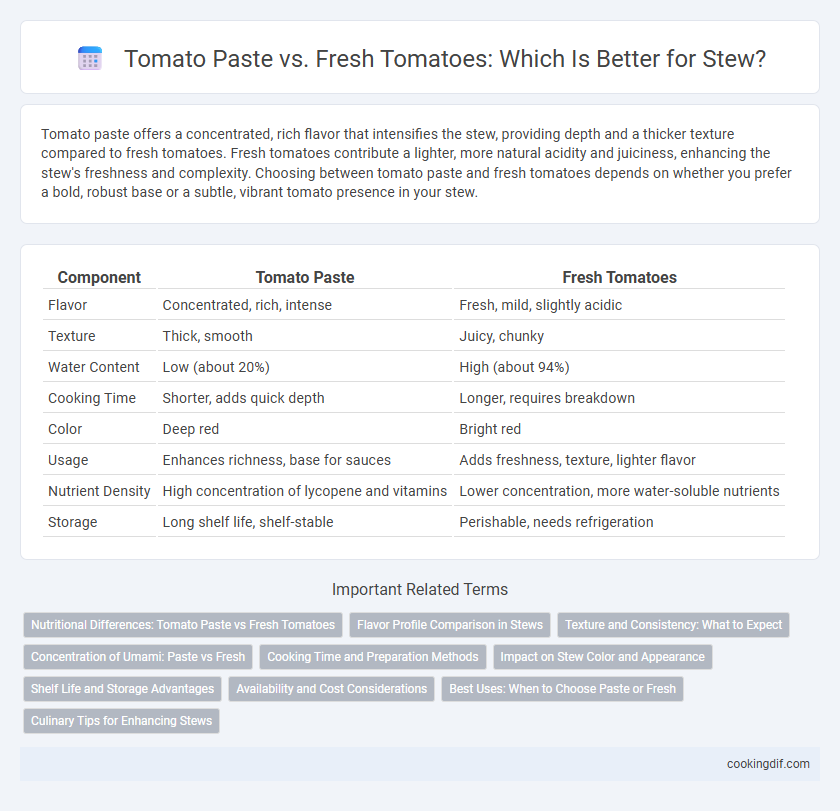Tomato paste offers a concentrated, rich flavor that intensifies the stew, providing depth and a thicker texture compared to fresh tomatoes. Fresh tomatoes contribute a lighter, more natural acidity and juiciness, enhancing the stew's freshness and complexity. Choosing between tomato paste and fresh tomatoes depends on whether you prefer a bold, robust base or a subtle, vibrant tomato presence in your stew.
Table of Comparison
| Component | Tomato Paste | Fresh Tomatoes |
|---|---|---|
| Flavor | Concentrated, rich, intense | Fresh, mild, slightly acidic |
| Texture | Thick, smooth | Juicy, chunky |
| Water Content | Low (about 20%) | High (about 94%) |
| Cooking Time | Shorter, adds quick depth | Longer, requires breakdown |
| Color | Deep red | Bright red |
| Usage | Enhances richness, base for sauces | Adds freshness, texture, lighter flavor |
| Nutrient Density | High concentration of lycopene and vitamins | Lower concentration, more water-soluble nutrients |
| Storage | Long shelf life, shelf-stable | Perishable, needs refrigeration |
Nutritional Differences: Tomato Paste vs Fresh Tomatoes
Tomato paste contains a higher concentration of nutrients like lycopene, vitamin C, and antioxidants compared to fresh tomatoes due to the reduction process that removes water content. Fresh tomatoes provide more vitamin C and fiber but in lower amounts per serving due to their higher water content. Both tomato paste and fresh tomatoes contribute beneficial nutrients, but tomato paste offers a more nutrient-dense option for enhancing stew flavor and nutritional value.
Flavor Profile Comparison in Stews
Tomato paste offers a concentrated, rich umami flavor that intensifies the stew's depth, providing a thick, robust tomato essence. Fresh tomatoes contribute a brighter, slightly acidic, and sweeter note that adds freshness and complexity to the stew's flavor profile. Combining both creates a balanced stew with layered tomato flavors, blending the boldness of paste and the natural brightness of fresh tomatoes.
Texture and Consistency: What to Expect
Tomato paste provides a thick, concentrated texture that enhances the stew's consistency with a rich, smooth base, ideal for slow-cooked dishes. Fresh tomatoes release more water, resulting in a lighter, chunkier texture that can vary depending on the tomato variety and ripeness. Using paste creates a uniform thickness, while fresh tomatoes introduce a more varied, rustic mouthfeel with occasional bursts of juiciness.
Concentration of Umami: Paste vs Fresh
Tomato paste offers a higher concentration of umami than fresh tomatoes due to its reduction process, which intensifies glutamates and other flavor compounds. The thick, rich texture of tomato paste boosts the savory depth in stews more effectively than the lighter, juicier fresh tomatoes. Fresh tomatoes provide a brighter acidity but lack the dense umami punch, making paste the preferred choice for robust, savory stews.
Cooking Time and Preparation Methods
Tomato paste offers a concentrated flavor that reduces cooking time significantly compared to fresh tomatoes, which require peeling, seeding, and longer simmering to break down. Fresh tomatoes provide a fresher taste and texture but need extensive preparation involving blanching and chopping, extending overall stew preparation duration. Using tomato paste streamlines the cooking process, making it ideal for quick stews, while fresh tomatoes enhance complexity and freshness in longer-cooked recipes.
Impact on Stew Color and Appearance
Tomato paste intensifies stew color by providing a deep, rich red hue that enhances visual appeal and creates a more vibrant dish. Fresh tomatoes contribute a lighter, more varied color with a natural, sometimes chunky texture that gives the stew a fresher look. Using tomato paste results in a smoother, more uniform appearance, while fresh tomatoes offer a rustic and dynamic visual quality to the stew.
Shelf Life and Storage Advantages
Tomato paste offers a significantly longer shelf life compared to fresh tomatoes, typically lasting up to 12-18 months when unopened and stored in a cool, dark pantry. Fresh tomatoes require refrigeration to slow spoilage and usually keep for only about 1-2 weeks before losing flavor and texture. The concentrated form of tomato paste reduces storage space and minimizes waste, making it a convenient, cost-effective option for stews where consistent tomato flavor is desired.
Availability and Cost Considerations
Tomato paste offers year-round availability and a concentrated flavor that reduces the quantity needed, making it more cost-effective than fresh tomatoes, which are seasonal and subject to price fluctuations. Fresh tomatoes provide a brighter, more nuanced taste but often come at a higher cost during off-season periods due to limited supply. Choosing between tomato paste and fresh tomatoes depends on budget constraints and the desired taste profile in stew preparation.
Best Uses: When to Choose Paste or Fresh
Tomato paste offers concentrated flavor and thicker consistency, making it ideal for long-simmered stews requiring depth and richness. Fresh tomatoes provide a lighter, more vibrant taste and moisture, perfect for stews cooked quickly or when a fresher tomato presence is desired. Choosing tomato paste or fresh tomatoes depends on cooking time and desired stew texture, balancing intense flavor versus freshness.
Culinary Tips for Enhancing Stews
Tomato paste offers concentrated flavor and a rich, deep color that intensifies the stew's taste, while fresh tomatoes provide a lighter, more natural sweetness and texture. For optimal stew results, combine both by sauteing tomato paste early to caramelize and boost umami, then add fresh tomatoes later for freshness and balance. Enhancing the stew's complexity relies on this balance between the robust, thick tomato paste and the bright, juicy essence of fresh tomatoes.
Tomato Paste vs Fresh Tomatoes for tomato component Infographic

 cookingdif.com
cookingdif.com